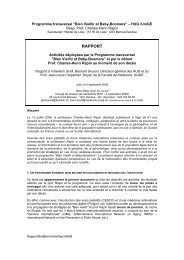Palliative care for older people - World Health Organization ...
Palliative care for older people - World Health Organization ...
Palliative care for older people - World Health Organization ...
Create successful ePaper yourself
Turn your PDF publications into a flip-book with our unique Google optimized e-Paper software.
of this vulnerable group are far from being met.Addressing this gap should there<strong>for</strong>e be a primepublic health concern.This publication builds on the previous two bygiving specific examples of promising or betterpractices in palliative <strong>care</strong> <strong>for</strong> <strong>older</strong> <strong>people</strong> alongwith evidence of their effectiveness when this isavailable. This project is the work of a EuropeanAssociation <strong>for</strong> <strong>Palliative</strong> Care (EAPC) Task Force.“...<strong>older</strong> <strong>people</strong> suffer unnecessarily, owingto widespread underassessment and undertreatmentof their problems and lack of accessto palliative <strong>care</strong>.”Better palliative <strong>care</strong> <strong>for</strong> <strong>older</strong> <strong>people</strong> (3)The examples have been identified from literaturesearches and from an international call <strong>for</strong> examplesthrough various organizations, including theEAPC and the European Union Geriatric MedicineSociety. This publication aims to help those involvedin planning, funding or developing servicesmost appropriately and effectively. This guide isdeveloped <strong>for</strong> countries in the WHO EuropeanRegion. Where possible, examples from the Regionare used. However, some examples from outsidethe Region are included when these are consideredmore innovative or more rigorously evaluated thanEuropean examples and are relevant to Europeansettings. <strong>Palliative</strong> <strong>care</strong> needs to be improved <strong>for</strong><strong>older</strong> <strong>people</strong> in countries with fewer resourcessuch as those in Africa and Asia. However, thehealth <strong>care</strong> systems and the challenges to providingpalliative <strong>care</strong> are very different in these settings,which is why they remain largely outside the remitof this publication. Although some of the examplesare not originally intended solely <strong>for</strong> <strong>older</strong> <strong>people</strong>,they have been included because they illustrate <strong>care</strong>that could also benefit this group.Many palliative <strong>care</strong> services provide <strong>care</strong> <strong>for</strong><strong>people</strong> from different age groups. This publicationdoes not have space to cover many other examples;these are available from the Department of <strong>Palliative</strong>Care, Policy and Rehabilitation of King’s CollegeLondon (http://www.csi.kcl.ac.uk/palliative).Why better palliative <strong>care</strong> <strong>for</strong> <strong>older</strong> <strong>people</strong>is an urgent public health priorityAgeing demographicsThe proportion of <strong>people</strong> aged 65 years and <strong>older</strong>is steadily increasing in the WHO European Region.In 2009, this age group represented almost 15%of the population of most European Union (EU)countries (Fig. 1.1) (4).2
















